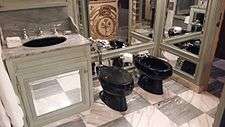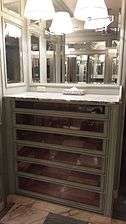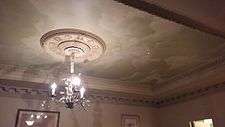Robert Denning
Robert Denning (March 13, 1927 – August 26, 2005) was an American interior designer whose lush interpretations of French Victorian decor became an emblem of corporate raider tastes in the 1980s.[1]
Robert Denning | |
|---|---|
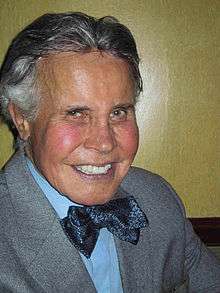 Robert Denning, c. 2002 | |
| Born | Robert Dennis Besser March 13, 1927 New York City, US] |
| Died | August 26, 2005 (aged 78) New York City, US |
| Occupation | Interior design |
| Partner(s) |
|
Early life
Denning was born Robert Dennis Besser in New York City, New York, to Jean (née Rosen) and Jacob Besser. Denning, as he was often called, developed an early interest in his body and health, a characteristic instilled in him by his mother. He was just fifteen when he met Edgar de Evia[2] who was the research assistant to Dr. Guy Beckley Stearns and would go on to become a noted photographer. He became a testing subject for this Homeopathic medical research and when his parents and younger brother moved to Florida, he stayed in New York City living with de Evia and his mother Miirrha Alhambra. He would often say that he saw his first lampshade in this home, as he grew up with a bare bulb being adequate.[3] His first effort with decorating was perhaps in imitation of Syrie Maugham when Edgar and he, painted everything in Miirrha's room white and put her bed on a dais. Her only response was: "Did you have to paint even my Baccarat perfume bottles?" He never used white again.[3]
Denning & Fourcade
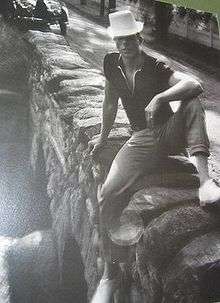
From 1960 the firm of Denning & Fourcade would become known for colorful extravagance and over the top opulence. Clients beginning with Michel David-Weill;[4][5] the Ogden Phipps family,[5] for whom they did fifteen houses;[4] Henry Kravis,[6] whose home, and their decorating, was parodied in the 1990 movie "The Bonfire of the Vanities"[7] with Tom Hanks;[5] Charles and Jayne Wrightsman;[6] Henry Kissinger;[6] Diana Ross;[5] Oscar de la Renta[3] both in Manhattan[8] and Connecticut;[9] Beatriz and Antenor Patiño, the Bolivian tin magnate[5] and Jean Vanderbilt,[3] to name only a few, began to roll in. Soon they were established and known for creating an established and 'old money' atmosphere anywhere. For thirty years they were courted on both sides of the Atlantic.[10] Denning kept the fragrance Sous Le Vent in his automobiles to remind him of Lillian Bostwick Phipps who always wore the scent. Longtime clients such as Spencer Hays,[11] the Richard Merillats for whom he has designed homes in Naples, Florida[12] and Michigan, the Countess Rattazzi, for whom he did homes in Manhattan, South America and Italy (15 houses in all)[13] looked forward to shopping sprees with him be it in the wholesale import markets in New York City or the Paris flea market. Denning's five story townhouse for Phyllis Cerf Wagner is described as: "... cozy and grand at the same time, but not elaborately fussy."[14]
Eugenia Sheppard of the New York Herald Tribune dubbed their work "Le Style Rothschild." It reeked de l'argent. "Outrageous luxury is what our clients want," Denning & Fourcade said. This was the 1980s, the era of instant wealth. They visually defined it, giving crisp money the appearance of provenance and what Denning called "a casual English attitude about grandeur."[3]
Often perceived as "...the Odd Couple. Boyish, down-to-earth Denning is the hardest worker, while Fourcade sniffs the client air to gauge if it's socially registered before he goes beyond the fringe."[3][15] Jewelry designer Kenneth Jay Lane developed a passion for art pieces from the Middle East which the firm was in the vanguard of introducing and has also used some of their lighting treatments.[16] Denning designed Jason Epstein's SoHo home[17] from scratch in the shell of the building that housed the first consolidated New York police department.[13] This was an entirely new effort for the designer who is known by many to specialize in a period "we'd call early-fringed-lampshade, but chic".[18]
They would also amass a large collection of artwork and bronzes. They would commission original works of art and collect many of the same artists that they would recommend to their clients.[19]
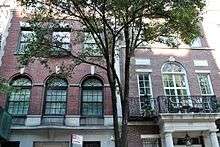
Fourcade and Denning shared a red brick mansion on East 73d Street in Manhattan and a house they built in Bridgehampton, Long Island; both houses were the subjects of articles in decorating magazines around the world.
After Fourcade
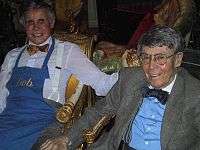
Denning 'reinvented' himself to use his own word, after Vincent Fourcade's death from AIDS in 1992. Taking a lighter approach with more emphasis on effect and comfort than signed pieces of furniture, he used to laugh at how he would coach his early clients with decorating their children and grandchildren's homes.[20] He was listed in the AD100, top hundred decorators by Architectural Digest for a number of years and once said: "I'll accept commissions from anyone who isn't frightened by my proposals."[21] Also listed in New York The Top 100 Architects & Decorators and The New York Times Magazine in an article "Who Made It" he was listed as one of 15 interior designers who had become "celebrities in their own right".:[22]
- Technology permitting, Robert Denning would happily return to the nineteenth century. Since he can't, he devotes himself to re-creating – with international mixes of opulent furniture – the sumptuous interiors of his favorite era, using damask, silks, and taffetas.[23]
His jobs have appeared not only in AD's pages, but those of every major magazine with home interiors. He always participated in charity benefits such as the auction to benefit Friends In Deed, a counseling organization for people with AIDS and cancer[24] to decorating the main foyer of the von Stade mansion to benefit Southampton's Rogers Memorial Library.[25] He was one of the decorators that contributed to the restoration of the 1932, 50 room mansion, of William Goadby Loew for the Smithers Alcoholism Treatment and Training Center on Manhattan's upper East side.[26] "A sense of humor overlaying a deep commitment to style and a consuming passion for detail characterize all of Denning's work."[27]
During the last decade of his life he tired of Paris, giving up his home that he had shared with Vincent in the 17th arrondissment. He was content in the familiar surroundings of his home and offices in the Lombardy Hotel in New York City, where both the lobby [3] and restaurant were of his design.
He died in his apartment in New York City in 2005. His personal estate was featured in an auction at Doyle New York on May 17, 2006.
Robert Denning Suite at the Lombardy
References
- Life In Legacy – Week of August 26, 2005 retrieved June 29, 2006
- AD Designers Architectural Digest's January 2002 Special Collector's Edition Announces The New "AD 100" Top Interior Designers and Architects reproduced on their webpage AD 100
- "The Sweet Smell of Excess" by Patricia Volk, October 8, 2006, The New York Times online retrieved October 4, 2007
- "Past Perfect in Paris–A Richly Detailed Apartment for a New York Designer" by Annette Tapert, Architectural Digest, October 1995, v. 52 #10, pp. 168–173
- "Vincent Fourcade, 58, Decorator Known for His Ornate Interiors" by Carol Vogel, December 25, 1992, The New York Times online retrieved October 17, 2007obituary
- The Best Revenge (Isn't It Always) by Dan Shaw, October 15, 2006, The New York Times online retrieved December 30, 2008
- in:sensedesign Archived 2009-04-27 at the Wayback Machine
- "In the de la Renta Fashion" by John Richardson, House & Garden, December 1985
- House & Garden July 1986
- "Robert Denning Dies at 78; Champion of Lavish Décor", by Mitchell Owens, September 4, 2005, The New York Times obituary
- "Manhattan Grand Luxe – Richly Appointed Rooms For Collectors", by Aileen Mehle, Architectural Digest, September 1994, v. 51 #9, pp. 126–176
- "Florida Renaissance – Italianate Splendors Enrich A Villa in Naples", by Suzanne Stephens, Architectural Digest, October 2000, v. 57 #10, pp. 284–298
- "Editorial Statement – Brushing Up Jason Epstein's Downtown Loft", by Judith Thurman, Architectural Digest, March 1995, v. 52 #3, pp. 186–200
- "Wendy's Warren" by Max Abelson, The New York Observer February 12, 2007 online retrieved September 27, 2007
- "Inside the Decorating Establishment – The Ant and the Grasshopper" by Rosemary Kent, New York, April 28, 1975
- Home Design 2002: Jewels in the Town by Bob Morris, April 8, 2002, New York online retrieved June 29, 2006
- "A Vision for Books That Exults in Happenstance" by Dinitia Smith January 13, 2001, The New York Times online retrieved August 9, 2009
- "Scull-Duggery: The Split Goes Public" by Joan Kron, New York, January 20, 1975, p. 52
- Collections including the artist Andrew Zega retrieved June 29, 2006
- "Flying Solo-Robert Denning talks about the grandeur he has known-the rooms and the clients", W At Home
- The AD 100 Architectural Digest January 2000, v. 57 #1, p. 48
- The New York Times Magazine, October 15, 1989
- The Top 100 Architects & Decorators October 14, 2002, New York online retrieved June 29, 2006
- Buttons, bows and Damask: Designer Chairs at Auction by Elaine Louie, December 12, 1996, The New York Times online retrieved June 29, 2006
- Southampton Show House to Open Doors by Suzanne Slesin, June 30, 1983, The New York Times online retrieved June 29, 2006
- "A Renewal For a Place Of Renewal" by Elaine Louie February 3, 1994, The New York Times online retrieved August 9, 2009
- "The More the Merrier – Robert Denning's Extravagance of Color and Pattern", by Cynthia Zarin, Architectural Digest, April 2002, v. 59 #4, pp. 146–152
External links
| Wikiquote has quotations related to: Robert Denning |
| Wikimedia Commons has media related to Robert Denning. |
- Robert Denning and Vincent Fourcade's Official Homepage
- Robert Denning at Find a Grave
- Edgar de Evia's Official Homepage
- Melvin Sokolsky's comments on meeting Bob at the gym and then meeting Edgar de Evia.
- ARCHITECTURAL DIGEST 100 top designers
- Franklin Report card at The Franklin Report
- Results and background of the estate sale of Robert Denning at Doyle New York.
